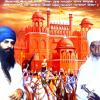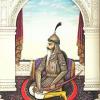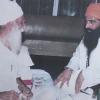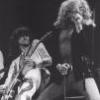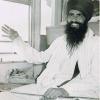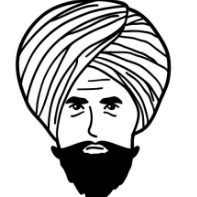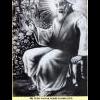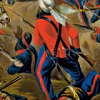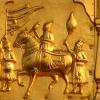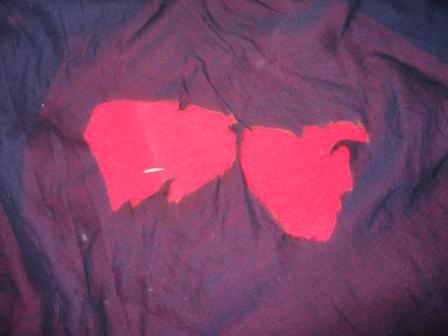Leaderboard
Popular Content
Showing content with the highest reputation on 11/27/2012 in all areas
-
if we look at the way puratan Gurdwara's were built ie hazoor sahib or harmandir sahib...they were always kept small in size. The sole reason appears to be is that is small buildings can only host small numbers, resulting in teachings being propagated on a personal level & Guru Jee and puratan Sikhs knew this. i feel it's very important the Gurmat classes are taught in small numbers (eg 25 max) on a regular basis (once a week) where the youth parcharak can build a bond with the kids. in my experience, firstly the teacher needs to show that we're human...as stupid as it sounds but most kids think Gursikhs are like robots who can't have a laugh. Next a teacher must prove themselves of being worthy of respect, by knowing what they're talking about and finally the teachers has to let the kids into theirs life by sharing their life experiences at work, interfaith events! In my experiences kids are more engaged when you talk about your life and interactions and will listen attentively. Whereas they will zone in and out when you talk about Sikh itihas. So it's for each teacher to relate sakhi's of our Guru Sahibs and make them relevant today...make it relevant to their lives! As offensive as this may sound but kids don't care too much about 500yrs ago and that's the truth. But a good teacher has the ability of making 500yrs ago sound very important, provided they link itihas with how it's relevant today. But non of the above accounts for anything if the teacher doesn't have passion in their composure, their voice, their eyes. Kids pick up on these more than what you say. They take on board what you don't say too...it's very interesting. Don't be judgmental...don't tell them out to live their lives. My approach is simple...connect kids to Gurbani and maharaaj will do the rest. And finally, don't try to control kids..the moment you do, is the moment you have lost them. You will have to let them make their mistakes but you should create such a relationship that they feel they can always come to you even if they do mess up and you won't judge them. I'm shocked and horrified about what i hear 13/14yrs old get upto today...but we have to start somewhere, it's never too late. Also teaching needs to be audio, visual & kinesthetic...so don't just talk to them for 1hr. On average kids will only remember 5% of what they heard in a lecture. You need to add more dimensions to teaching to ensure all kids are engaged. All in all....teaching is hard! I took my class to an interfaith event and they had to manage a sikh stall, also part of this event there was an activity where each person in a room had 90secs to speak to another person about their faith and then listen to the other persons faith....each person had to speak to everyone in the room. We had older ppl and young kids in one room in rows. This really pushed and challenged the kids to step up as they needed to quickly figure out how to articulate Sikhi in such a small amount of time. I received amazing feedback from the local Bishop and event organisers...we just need to allow kids to step up as we seem to be raising a generation of kids who feel only Brahmgiann's should be allowed to discuss Sikhi at interfaith events or even Gurdwara's. that's my 2 cents...i'd be interesting is hearing about what others think.7 points
-
Dhan Dhan Dhan Dhan Guru Nanak Sahib Ji Maharaj and Akaal Purakh Waheguru are one and the same. Look at it this way; Imagine if you standing infront of the ocean and you take a glass and fill it up with water from the ocean, its still the same water inside the glass and the sea. Same way think of Akaal Purakh being the ocean and Maharaj Ji being the glass. Please sangat ji forgive me if I've said anything wrong.4 points
-
Those propogating Sikhi and those seeking to learn it, need to have a certain mind and skill set. without this, Sikhi Parchaar will always fail. Gurbilas Paatshaahi Chhevi has a beautiful sakhi where Guru Hargobind Sahib Jis Gursikhs ask him a question along the lines of this discussion (core concept): Be inspired and let others know what it takes to be a parchaarak and a student: Taken from Sant Waryam Singh Ji’s Kathaa: Invocation: True and supreme is God’s Name. Blessed is Sri Guru Nanak Dev Ji. ‘Prostrate salutation and obeisance I make many a time before the omnipotent Lord, the Possessor of all the powers. Reach me Thy hand, O Lord and save me from wavering, says Nanak.’ ‘After wandering and wandering, O Lord, I have come and entered Thy sanctuary. O Master, Nanak’s prayer is: Attach me to Thy devotional service.’ Refrain: Cast off is d oubt from my mind O dear, ever since I have had a glimpse of Thee. ‘Lord; to Your shelter have I come, since having a sight of You, cast off is doubt from my mind. Without a word have You known my state, And devotion to Your Name inspired. Fled is suffering, and in joyful serenity am I absorbed, As in joy Your laudation I have sung. By grasping my arm has the Guru succoured his servant From evil stars and the dark well of Maya (Mammon). Saith Nanak: The Guru our bonds has snapped And to the long-separated granted union.’ Holy congregation! loud be thy utterance: ‘True and supreme is God’s Name’. Getting free from your worldly chores, you have reached the Guru’s court. If the congregation of the holy and true is attended in the prescribed manner, it proves to be immense fruitful. Unless we fully understand the discourse, we are incapable of gaining full advantage of it, though we come from home leaving our worldly chores for this purpose. For a person of average intelligence, it is like this. A machine may be having a number of wires connected with one another with screws and producing a voice. If the voice comes clearly, as my voice is coming, the listener is benefited fully. But if one or two wires do not function, there will be confusion, and nothing will be intelligible. The loudspeaker will not function properly. The hall will reverberate with the sound, as it is doing now, because everything has to be done in a proper manner. When something is done fully in the prescribed manner, the result is full, right and proper. Man can mend it as much as required. This is not to say that, that is all. Generally, those who come to attend a holy congregation should have fourteen virtues, and the speaker too should have fourteen qualities. In this connection, four Sikhs – Bhai Mansadhar, Bhai Dargah Tali, Bhai Takhat Dhir, and Bhai Tirath Uppal – came together to the Sixth Guru Sahib and prayed, “O True, Sovereign! we listen to holy discourses. Your Gursikhs (disciples) explain to us with detailed meanings, but even then why don’t we get joy and peace of mind? Our mind continues wandering in different directions. But when we listen to ‘kirtan’ (singing of Gurbani)-cum-explication from Bhai Nivala and Bhai Nihaloo, we are filled with fear of sins and evils, and we feel inclined to give up evil thoughts and wickedness, and start imbibing Gurmat (Guru’s teachings) and the light of Divine knowledge and understanding is lit within us. O True Sovereign! why does it happen that while listening to the discourses of many persons, our mind does not become absorbed in them at all? On the other hand, there are some discourses in which the wandering fancy becomes still and concentrated in the mind. At this Guru Sahib said to them, “O Gursikhs! there is a proper method for attending a holy congregation in which both the speaker and the listeners have a responsible role to play. Generally, fourteen qualities are needed in the speaker and fourteen in the listener, and only then does it prove to be perfectly fruitful, otherwise not.” On that occasion, the Sikhs requested Guru Sahib, “O Master! kindly tell us in detail the qualities of a good speaker. We are your servants; we shall be greatly benefited when we come to know about the qualities of a good speaker and a good listener.” Guru Sahib said, “The first quality of a speaker is that his utterance should be pleasing, steady, sweet, gentle and humble; i.e. free from pride. He should know the meanings of the ‘shabad’ (hymn) fully. The second quality is that he should speak as loudly as warranted by the number of listeners. If there are devotees sitting upto some distance, and he speaks in a low tone, then those sitting nearby will be able to hear him, but not those sitting at some distance. ‘Chhand’ (stanza or song) and ‘dharna’ (refrain) should be recited or sung at the required pitch. Thirdly, he should know how to explain the subject in detail, and how to express it in a brief manner. He should be acquainted with both the arts. He should keep an eye on the congregation to see whether what he is saying is interesting them or not, or whether it is going home to them or not. He should continue observing the listeners’ attention carefully. He should state a subject in as much detail and depth as is intelligible to them. The moment, their attention starts declining, he should stop explaining in detail and wind up the subject briefly. Fourthly, he should be capable of describing the context of his discourse and the illustrative stories therein in a gentle, loving and appealing manner. He should make his utterances so sweet that they may sound charming to them. Fifthly, every utterance from his tongue should be true and about truth. In the holy congregation, he should not utter anything which is purposeless or fruitless. He should talk about ‘karma’ (deeds), worship and devotion, and Divine knowledge according to the mental and spiritual level of the listeners. He should be competent to explain the doctrine fully and should explicate by drawing conclusions or through careful discrimination and discernment. The sixth quality of a good speaker is that whatever doubts and misgivings appear to be rising in the course of the discourse, he should dispel them by giving examples, and if some listener asks a question, the speaker should know the art of answering it to the satisfaction of the questioner. He should be capable of explaining the central idea of the ‘shabad’ (hymn) clearly, and in support thereof, he should be able to give illustrations from old tales and stories or the proofs adduced by holy men. He should give examples only after estimating the listeners’ level of intelligence and understanding lest he should continue to display his learning which goes above their heads. The examples given should be such as the listeners can understand. Seventhly, the speaker should be fully conversant with the scriptures of all religions, their controversies and debates. He should not criticize any other religion or its scripture, and should quote only that much writing or utterance which agrees with his own religious doctrine or tenets. The eighth virtue is that he should not allow any digressions in his discourse. He should not digress and should speak with reference to the subject of the discourse. He should not talk about things which are unrelated with or irrelevant to the topic. He should take only those illustrative stories from other religions which resemble with Gurmat (Sikh doctrine) and help in understanding its meaning or objective. The ninth quality is that the speaker’s posture should be perfect and flawless. He should sit with his back straight, and similarly, he should keep his mind also simple, straight and guileless. The tenth quality is that, from time to time, he should make such utterances also which please the listeners and create love and reverence for the Guru (Perfect Holy Preceptor). In this manner, he should enthral the entire audience. He should ensure that the listeners sitting in front of him are listening to him attentively, and none is looking hither and thither. The listeners should be all attention waiting eagerly for what he is going to say next. Eleventhly, he should not feel proud, thinking that he is speaking well and the listeners are listening to him attentively. Eschewing every kind of pride, he should keep his mind humble. In spite of possessing many virtues, he should not feel proud and cultivate humility. In the twelfth place, he should not belittle any person. He should not intentionally make any critical comment by keeping any particular individual in mind. His own life should be thoroughly religious and pious and the listeners should have keen longing and devotion for listening to his discourses. The thirteenth quality of a good religious speaker is that before making any utterance, he should first imbibe and follow it in his own life. In other words, before preaching anything, he should first practise it himself. The fourteenth important quality is that he should cultivate and practise contentment. He should be satisfied with his lot or destiny. He should not resort to any means to extract money from the congregation for his own self. He should accept only what is offered voluntarily as a token of reverence for Gurbani. What is received without any request and demand is like ‘amrit’ (nectar). He should not pray even in his heart or mind that he should receive wealth and clothes in abundance. Thus, these fourteen qualities are essential in a religious speaker or explicator. Once again I repeat them in brief: 1. He should be capable of speaking in a sweet and pleasing tone. (2) He should be capable of explaining things in detail in keeping with the listeners’ inclination or interest. (3) He should be in a position to be brief, if needed. (4) He should be able to tell interesting illustrative stories. (5) He should be capable of uttering clear and precise sentences. (6) He should have the ability to dispel the listeners’ doubts? (7) He should be familiar with all the scriptures. (8) He should not give contrary proofs or examples with reference to the topic being discussed. (9) He should sit in a correct posture, which is appealing to the eyes. He should not make superfluous gestures or movements with eyes, nose, ears, hands and fingers or needlessly move his hand over his head. He should sit in a straight and erect posture. (10) He should delight the listeners’ heart. (11) He should be able to win all. (12) He should be free from pride or vanity. (13) He should be of religious and pious thinking without any difference between his words and deeds. He should not repeat the utterances of others, or what he has heard from others. (14) The biggest attribute is that he should be contented with his lot, and should not feel attracted towards Maya (material riches). Similarly, a good listener too has fourteen qualities. He should have faith in and devotion for the speaker in thoughts, words and deeds. Secondly, he should not have any pride in him. Thirdly, he should listen to the speaker with perfect love and devotion. Fourthly, there should not be any counterargument in his mind. Fifthly, he should not be capricious and should not practise cunningness in words and deeds. He should listen to the speaker attentively and endeavour to comprehend his discourse. Sixthly, he should have the ability to ask questions about the discourse he has heard. Seventhly, he should have heard about all the scriptures. Eighthly, he should not be lazy or lethargic, and listen to the speaker’s discourse by sitting straight and erect and free from all other thoughts in the mind, either with closed eyes or with eyes fixed on the speaker’s face. Ninthly, when he is listening to the discourse, he should not let sleep or indolence come near him. Tenthly, he should have the nature and temperament of sharing his earnings with the needy. Eleventhly, he should imbibe in the heart and mind whatever he hears at a holy congregation. Twelfthly, he should not be opposed to or critical of the Gurmat doctrine in any way exactly as, he has heard what the Guru has said: ‘O my mind! why thou art fallen into this brooding? The Lord Himself on thy behalf is making endeavour; In rocks and stones has He created living creatures, Whose sustenance He there provides.’ Considering it an absolute truth, he should follow it in his life. He should not entertain any doubt or criticism with reference to the Guru’s utterances. The thirteenth quality which is very essential in a good and pious listener is that he should not attend a holy congregation dressed in dirty and foul smelling clothes; he should not yawn and should come to the company of the holy only after cleaning his bowels, so that he does not pass out wind there. Fourteenth requirement for a listener is that he should not practise any hypocrisy or affectation. For example, where a very moving discourse is being delivered, he should not shed false tears without being really touched, and try to attract the attention of other devotees thereby. When the speaker and listener possess the required qualities, then as per the Guru’s edict: ‘Merit of million-fold sacrifice comes to such as listen to, and chant the Lord’s Name.’ Until these 28 attributes (of the speaker and the listener) accord with one another, we are deprived of reaping the great advantage of attending the holy congregation. So, all of you have been attending holy congregation for a long time, but if man is not careful and attentive, nothing is gained even after much effort and labour. Just as a farmer has land and he does farming, but if he does not know how deep the seed is to be sown, and how manure is to be put, whether it should touch the seed or not, and then if he does not know how much the leveller is to be applied, how heavy it should be, when the field is to be watered and when the weeds are to be removed, he cannot get a full or rich crop. That farmer, who neither knows about wetness of the land, nor about putting manure, nor about other moistures in the land, cannot get a good crop. If excessive water is given to the wheat crops in the month of ‘Chet’ (Indian month coinciding with February and March) it will sag. However good the crop may be, the yield is reduced to half. In paddy crop, if excessive urea is put, it will appear black, and one will be delighted, but when the fruit comes, it is not even 1/4th of the average fruit. Then man sadly wonders what has happened – ‘My crop was the best of all. Everybody stopped to watch it with joy and surprise.’ His companion with a weak mind remarks, ‘Brother! your crop was excellent, but since you did not put up a black pot to ward off evil eyes, it has been destroyed by someone’s malevolent eye.’ But what is the reality? There is no such thing as being influenced by an evil eye. The truth is that he put excessive urea due to which, after growing quickly, when it came to seeding, it sagged and got diseased. So there was nothing lacking in effort or labour; what was lacking was that the person did not know the right and proper method or procedure, and did not have full knowledge. So, in this way, you may take up any task in the world – industry, transport or business – if proper method is not known, man does not get full reward, even if he invests the required capital.3 points
-
I think you missed the gist of my post. Being "hardened" as you call it was not the point I made here. I merely wrote down the situation of the Sikh people in 1947 and what could have been if we only had the right leader to take advantage of the situation. Even MI5 at the time seems to have thought that a Sikh national state was imminent. But Sikhs were too trusting of Nehru and gandhi. Of course no one wants to suffer a genocide. But look at it this way, the fact that Sikhs did not take advantage of the situation of 1947, the result is we suffered the catastrophic genocide of 1984 and after.2 points
-
Mahapursh tell that avtar do not evolve in the body during the nine months in the mother's womb. The body after birth gets parkash so it is basically wrong to bring the avtars and normal humans on the same level! I don't have the audio of Sant Kartar Singh Bhindranwale or other Mahapursh who tell about this. Moreover if anyone wants to attain self realisation it is important for a sikh to not to differentiate between Guru and Waheguru. 'Gur Govind Govind Guru hai Nanak Bhed Na Bhai' Guru is God, God is Guru, Nanak does not the differentiate between these.2 points
-
Very true. No one is saying Badal is good. He is corrupt, but alteast he keeps away from religious affairs. He sticks to his corrupt politics and money making. But Sarna is trying to change the very foundations of Sikhi. He is THE one who is promoting the heretic Kala Afghanis. Without his active support, these heretics would have been side lined long ago. Sarna may be smaller than Badal, but the damage being caused by him is at the very foundations of Sikhi. Sarna is just following the dictates of his masters in the congress party who are the worst enemies of the Sikhs since 1947.2 points
-
Just a slight correction. The Jammu Dogras are not Brahmins, they are Rajputs. The Pahari Rajas who fought against the 10th master were Rajputs not Brahmins. Plenty of Jats were traitors through out Sikh history. But just because we are now in majority we like to overlook this little fact. If Sangat comes to the Gurdwara they should not be abused just because of their caste. This is not what our Gurus taught.2 points
-
Gur Parmesar Eko Jaan Guru and Parmeshvar are One and the same2 points
-
I have never been asked this question but i would say: Guru Sahib kirpa karke paath karaa lainde. Mein kaun aa karan wala. Or you can ask them about their bank balance and when they say its personal or something, say bani you read is also like your bank balance and you wouldn't disclose the amount. But never say how much you do. Guru Rakha2 points
-
People u am looking to sell all the books and material I have for cost prices if anyone is interested in anything contact me on my email, thank you, the email address is kam1825@hotmail.com1 point
-
Here is a nice Sakhi of Guru Nanak Dev Ji for a Friday afternoon. On one of his travels Guru Ji came to a town and stopped at the house of an old Sikh called Chundhwadi. He was very poor and was in a fluster as to what food to place in front of Guru Ji. He went to the local town not knowing what to do. While he was there he saw a gathering of people and went to see what was happening. It was a wrestling match and the local Nawab was parading his champion. Now, the champion was called Maskeen and was tall and muscular and was undefeated. He stood while the proud Nawab challenged all the town if there was any person who would take on his champion. Maskeen strode into the middle of the large circle flexing his muscles. No one dared step forward for fear of serious injury. When Chundhwadi heard that the prize was 50rps he thought that if he could get the money he could use it to buy provisions to place in front of Guru Ji. He stepped into the ring and declared his intention to wrestle Maskeen. All fell about laughing, how could such an old man who was just skin and bone take on the mighty Maskeen? As the two opponents came close Maskeen asked “What are you doing old man? You have no chance against me, what possesses you to fight me, you are going to get seriously hurt” Chundawadi said “Oh champion, Guru Nanak Dev Ji is coming to my house today and I have no food to place before him, my only chance is to beat you and use the prize money.” Maskeen fell into thought, “I have heard of Guru Nanak” he said “they say he is Khudha himself. I would also like to meet him.” After much soul searching he said “Old man, if I let you win will you take me to see Guru Nanak?” “Yes” said Chundawadi “but what will become of you? If you lose, and lose to an old man your patronage will end and what will become of you?” But Maskeen did not hear this, all he could think about was meeting Guru Nanak. So it happened that after a few moves Maskeen fell to the ground with a thump and as planned the old man put his foot on his chest and claimed the prize. There was pandemonium, there was a riot, the proud Nawab was humiliated and disowned his wrestler. Maskeens reputation was ruined, he knew that he would be turned out of his house. His family were even more livid, when they heard what had happened they planned to do away with him. They hastily dug a trench under his munja and stuck in spikes and covered the whole thing with large palm leaves, they planned to murder him and then plea with the Nawab to let them stay at the house. As Maskeen finally got away from the crowd he could not find Chundawadi in all the commotion and wondered home. His favourite daughter met him on route. She had seen what was happening and told her father. But Maskeen was a broken man, he did not care what happened to him, he shuffled to his house and went straight to the munja and lay on it fully expecting the whole thing to collapse into the hole underneath, but nothing happened. His little daughter ran to him and peered underneath “Papa, I can see a man in robes holding up your munja” she shouted. He knew, he just knew. Maskeen jumped off the bed and before he knew it Guru Nanak Dev Ji stood before him. He fell to his knees placing his head on Guru Jis feet. Guru Ji sat him down. “Oh Maskeen, you were willing to lose everything for me, I am now here for you” Guru Sahib Ji blessed him and said that he would be remembered for always. Fifth saroop, Guru Arjan Dev Ji adds Maskeens name to the 15th Sloke in Sukhmani Sahib Ji – “ Sukhi vasay Maskeenia aap nivaar tallay, wudday wuddy hunkarian Nanak garab gallay. “1 point
-
i heard off a few ppl that guru gobind singh ji sed dat we shldnt trust sikhs wearing black patka/pagh as it is color of the enemy? This true?1 point
-
lal singh and tej singh were bhaiyas from UP and were not brahmins. Brahmins do not write singh with their names. Brahmins who came to Guru sahib were from kashmir. The point here is ill treatment of yatris by sarna. No one whosoever he is should be ill treated in a Gurudwara. Gurudwaras are open to everyone.1 point
-
1 point
-
Sikhs in 1947 had a lot of potential. In 1947 we were dominating the Indian army. In fact many generals were Sikhs (many of whom mysteriously died in a plane crash during the 1st Kashmir war). Add to this thousands of battle hardened ex soldiers who had fought in WW2. The Sikh princely states also had their own royal Sikh armies who were also battle hardened from WW2, the patiala army was particularly very strong. Then we had so many Sikh men who were battle hardened by the violence in 1947 partion of Punjab. If only we had the right leader at the time Sikhs could have achieved so much by force. No one in India could have resisted the Sikhs at the time. May Guru jee bless us with a good opportunity in the future and a great leader to lead us.1 point
-
Sarna is running Gurudawaras as personal property. Two years back he did not allow Simranjit Mann to do ardas for 1984 victims at rakabganj Gurudwara sahib.1 point
-
1 point
-
YEAH MAN!! thats would be great, that way they cant flip out on each other in the same room!!! whats this about sweetness? ohhhh i see more tea time right? LOL!1 point
-
lots of people on this site are fans of babas (addressing them as mahapurakhs and what not )1 point
-
1 point
-
Bhainjee, I'm no one to lecture but as I myself have A LOT to learn. However, you are completely wrong there. This is a common misconception seen over and over again in Sikhs today. There are many places in GurBanee where Maharaaj says that there is no difference between God and Guru. Here's one off the top of my head: http://www.sikhitoth...p?ShabadID=3234 - Take notice of the Rahao panktee. Please read more into Sargun and Nirgun state of Waheguroo. You can start here: http://www.sikhsanga...irgun-nirankar/1 point
-
please read bachitter natak, guru says,,, har and harjan (hari da bhagat) are one, ॥ The Lord and His devotees are one, there is no difference between them. Just as the wave of water, arising in water, merges in water.60. and please also read bhatt sawiye in guru granth sahib ji, i don't say that guru sahib are god,but they are poorn saint, and the saint is true bhagat of god. sant te rabb ik mikk hunde ne,asi guru nu rabb ni kehnde, per oh ik mik ne , when you read gurbani and simran, it is the path of make two to one ik ton do ohi hoya, do ton ik kar dinda simran ,rabb ton bina ethe hor dooji koi cheez nahi, jha dekhte hai khuda hi khuda, khuda k bina kya koi shai juda hai,1 point
-
It sounds like they are mocking in some screwed up way. Reflect the question back to them; Tusi path karda hunda? Ji. Menu eh dasso, tusi path ka matlab ki jande? Tusin jande honde ki nitnem ka bani ki hunda Sikhan liye? Anything along those lines. Do not let them reel you in, but at the same time, keep them on the end of your line and do not let them off the hook!1 point
-
Sorry for the negativity. I was avoiding this thread for many weeks. Trying not to post at all on this forum, but a member was purposely trying to hide the true colors of 3HO. I wish i did not post. But no other member was addressing these lies.1 point
-
Watch this video, where Yogi Bhajan along with his family are seen worshipping an idol. http://www.youtube.com/watch?v=JKLNcRqWnKU The 3HO are very similar to Sarbjit Singh Dhunda. Throw in some good things just to keep the sangat listening, but then slowly slip in the poison when the Sikh is caught off guard. Bow your head at the teachings of Satguru Sri Guru Gobind Singh Sahib ji Maharaj and you don't owe anything to anyone. Satguru spreads Sikhi to the whole world and not idol worshippers. Idol worshippers spread their own religion.1 point
-
taken from 1984tribute.com Operation Black Thunder I - 30th April 1986 What became subsequently known as Operation Black Thunder I (April 30, 1986) whereby the Indian security forces recaptured the Golden Temple complex, Amritsar, from different varieties of militants was an important event in the current history of Punjab, after Operation Blue Star (June 3-7, 1984). The International Human Rights Organisation activists, D. S. Gill, Gurcharan Singh Grewal, Avtar Singh Gill, G. S. Bal and Bhupinder Singh Somal, in a team had enquired into the events and had compiled a detailed report. The report in a summarised form is being reproduced below. The period between June 1984 and April 1986 saw several ups and downs in Sikh politics. The Akali Dal led agitation has fizzled out in the wake of operation Blue Star. Militant Sikhs who were in disarray tried to reassemble their forces culminating in the January 26, 1986, Sarbat Khalsa (Sikh congregation at the Akal Takht), in the Golden Temple Complex. Within the militants, there were strands of thought and action. The Panthic Committee comprising hard-core militants led an armed struggle against the Indian State while a large number of militants followed Baba Joginder Singh, father of Sant Jarnail Singh Bhindranwale. The Baba led militants were operating semi-underground while the Panthic committee led militants were acting completely underground. On the other hand, the Shiromani Akali Dal led by Surjit Singh Barnala, and Balwant Singh, with Parkash Singh Badal, Gurcharan Singh Tohra, etc., trailing behind the Akali "haves," ran the State with the active co-operation and guidance of the Congress-(I) led Union Government. The Centre was quite worried about the re-emergence of militancy as an organised force even after the power had been allowed to be transferred to the Akali Dal. The Barnala ministry was embarrassed by the occupation of the Darbar Sahib complex by militants although the SGPC was in the hands of the ruling party. The Badal-Tohra faction that was virtually kept out of effective levers of power was not willing to confront the militants. This faction, in fact, was in favour of a compromise so that it could tilt the balance of Sikh power in its favour to the detriment of the ruling faction. Delhi was watching Punjab with keen interest. It strengthened its security forces and intelligence system in Punjab. The Barnala Ministry's Home Affairs were, in fact, in the Union Home Ministry’s hands, probably with an arrangement arrived at even before the Akali Ministry was installed into power. The execution of selected targets by militants was continuing. Every such development came as a big blow to the prestige of the Congress (I) Government at the Centre. The media and the public opinion elsewhere in the country attributed every militant action to their positions in the Darbar Sahib complex. On the other hand, the ruling group at Delhi was being cornered as a result of the growing opinion that the Operation Blue Star was unwisely conceived and executed. In this scenario, the Government of India was pressing the Barnala Government hard to evict the militants from the Darbar Sahib complex but Surjit Singh Barnala was dragging his feet. There was a pincer movement against him from the Centre and the militants. He finally opted for Delhi and against the militants. Barnala accepted the first step Delhi took to recontrol the situation- the appointment of J. F. Rebeiro as Director General, Police, and Punjab. Rebeiro was a Christian, not a Hindu. His command of the security forces in Punjab prima facie absolved him of the charge of being a Hindu communalist out to crush Sikhs. Second, Rebeiro was skilled in Portuguese fascist police training methods. There was obviously a Central plan at hand for Punjab. Delhi was planning to invade the Golden Temple complex. It was waiting for a suitable opportunity. Its only concern was that the action at the Darbar Sahib should ostensibly be taken by the Barnala Government and that it should not look like a Hindu action against the Sikh historic temple. Delhi persuaded Balwant Singh to play it card. He shaped the scheme of things by holding a so-called "Sarbat Khalsa" at Anandpur Sahib on February 16, 1986. General Jagjit Singh Arora was another active player of Delhi's game that he was later duly rewarded. Arora became a Member of Parliament (MP, Rajya Sabha). Circumstances leading to the "action" Immediate "provocation" to the operation undoubtedly was provided by the "declaration" on April 29 of "Khalistan" by the Panthic Committee. The news was received by Mr. Barnala when he was having tea with Mr. N. T. Rama Rao and Mr. Jyoti Basu at the Parliament House annexe where a reception was organised for "non-Congress (I)" Chief Ministers by opposition MPs. Most opposition parties fondly regarded Barnala as a non-congress Chief Minister. The announcement was dismissed by most as a non-event. Mr. Rama Rao said there was no need to panic and advised Barnala to ignore the "declaration." Mr. Basu said no cognisance should be taken of such an incident. Meanwhile, Mr. Barnala described the proclamation as "absurd, senseless and sacrilegious" that showed that "those elements and their foreign collaborators have become desperate in the face of firmness shown by his government." As stated above, the Centre was ready with its plans. Far from treating the Panthic Committee's announcement as a non-event, Rajiv Gandhi summoned Barnala at night, revealed his cloak-and-dagger tactics. Barnala agreed to accompany Arun Singh and Arjun Singh to make a mid-night trip to Amritsar to meet Rebeiro. The operation Black Thunder I had been planned although Barnala announced at a prolonged Cabinet meeting held at Chandigarh the next day- hours before the Amritsar action- that members of the Panthic Committee had vacated the complex. The IHRO Committee did not feel the necessity of obtaining the official version as Rebeiro at different Press conferences had narrated the story starting with raids on Guru Nanak Niwas, Guru Ram Das Saran and Akal Rest House at 4.50 PM on April 30. The operation lasted 14 hours. It was supervised by the Punjab Director General of Police (DGP) himself. According to him the operation was mainly carried out by the police through assistance was obtained from Para-military forces. About 200 Para-military youth (Private) made search operation in the inns of the Golden Temple Complex. In all, three thousand security persons were deployed around the complex. Mr. Rebeiro revealed that the operation was done in the wake of threats posed by the declaration of "Khalistan" by the Panthic Committee. About 100 persons were rounded up on April 30 including Akal Takht acting Jathedar Gurdev Singh. He further claimed that there was no resistance and no exchange of fire, and security forces used the minimum force. However, about 200 "stun grenades" were exploded which were non-lethal in nature but caused some damage to two rooms of the "Parikarma." The operation was carried out in two phases. The first lasted two hours. It involved a search operation that was done smoothly. The second phase started at 10.30 PM when more than 300 commandos resorted to firing. Among 300 persons rounded up from the Harimandir Sahib at 6 AM on May 1, included acting Jathedar of Akal Takht who surrendered on the advice of Giani Puran Singh, head priest of the Golden Temple. The security forces seized some weapons from the complex including one pistol, one revolver, a .303 rifle, a .12 bore gun, 20 cartridges of various bores, 15 swords and 10 spears along with a number of documents and Khalistan literature, according to Rebeiro. Out of 378 persons rounded up, 233 were arrested and others were let off. Of the arrested, 37 were non-Sikh Bangladesh citizens. The police registered cases of sedition against 56 persons, while the detention of the remaining 174 was of a preventive nature, the state police chief added. He asserted that at no stage did he seek Army assistance for the action. The purpose of the action had been achieved. The complex would be handed over to the SGPC "The declaration of "beginning of the battle" for Khalistan was the provocation for storming the Temple to liberate it from the anti-nationals," he stated. He, however, admitted that the police could not keep secrecy and the persons who actually made the "declaration" had escaped. He said that one person had died and two were injured. He stated that only three rounds were fired during the entire operation. Facts about the "operation" The official version of the incident by the DGP is approximately supported by the evidence available. However, there are few exceptions to the way it was carried out and some undisclosed facts and circumstances that was revealed when the matter was properly investigated and analysed by the Committee. Bibi Harinderjit Kaur testified, that hundreds of swords-wielding youths wearing saffron turbans were seen on the Parikarma (pavement around the sacred pool) when police and security forces poised to enter the Parikarma and there was no exchange of fire as 12 trucks carrying the security forces entered the complex. Jaspal Singh of United News of India (UNI) disposed that five Battalions of commandos were airlifted under the command of two Major Generals of the Indian Army. Three belonged to the Army known as "Black Cats" and two to Border Security Force (BSF). About of 600 commandos were involved. But he was not sure whether all the commandos were pressed into the operation. He further stated that the commandos entered the Complex with their shoes on. Another journalist Mahinder Singh rebutted the allegation that the operation was mainly conducted by the police. The commandos under the orders of Army Generals conducted the main operation in the Parikarma and Harimandir Sahib. The Police and commandos armed with automatic weapons searched the inns of the complex, Bibi Rajwinder Kaur stated. She also saw blood stains on the floor of Room Number 28 of Guru Nanak Niwas where an AISSF convened meeting had just ended. She further contradicted the allegation of the Police that no woman or child was rounded up. She, along with Bibi Harinderjit Kaur and a boy of eight were detained and lodged in Akal Rest House's room number 28 under the surveillance of security persons. Bibi Harnam Kaur, an old lady worker of Istri Akali Dal saw blood stains in front of Jora Ghar (Shoe-Deposit House), near Guru Nanak Niwas and also on the second floor of Langar building where, according to her, four persons were feared to be killed and two Central Reserve Police Force (CRPF) persons injured in a scuffle. The Committee also inspected the spot and found a bundle of black hair. However, a few journalists ruled out the possibility of resistance from any quarter except Parikarma and Darshani Deori. An eye witness stated that a boy of 15 was shot dead near Dukhbhanjni Beri and Mr. Ranjit Singh, Manager, Darbar Sahib, stated the names of injured as Mr. Nishan Singh, Mr. Harjit Singh and another Bihari Singh, all Sewadars of SGPC. The recovery of arms by the police including one gun and a rifle seems to be correct. The gun and rifle are licensed in the name of Jathedar Gurdev Singh. The press reports regarding the theft of the gold of Sri Akal Takht Sahib were vehemently denied by Baba Arjan Singh, an assistant of Sant Uttam Singh of Khadoor Sahib. The gold is lying intact under the custody of "Kar Seva" babas. These reports seem to be politically motivated. The different versions about the dead and the injured could not be supported by any evidence, but according to Bhai Bakshish Singh, two dead bodies were lifted form Darshani Deori by the security persons, whom he saw when he was reciting the holy book by the side of Akal Takht. Political repercussions The Sikhs, all over the world, were shocked. The operation, had quick repercussions. There was a crisis in the Akali Dal. The Akali "have-nots" were upset over the "State Government's action." They were perturbed that even a Panthic Government could send forces in the Golden Temple complex. As many as 27 ruling party Members of Legislative Assembly (MLAs) resigned from the Akali Dal (L) to form a new Akali party of their own. The Barnala Government was left in a minority. It received support from Congress (I) as well as from the Communist Party of India (CPI) and the Bhartiya Janata Party (BJP). There was no danger so long as the Centre wanted Barnala to continue. But the Ministry lost legitimacy among the Sikh masses. This operation was God-sent to the militants. None of them were inside when the operation took place. They quietly left the place after making the announcement. However, the group led by Baba Joginder Singh was nabbed by the police. The operation thus resolved the Panthic Committee versus Baba Joginder Singh tussle to the detriment of the Baba. The armed militant youths continued and stepped up violence outside the complex. A significant aftermath of the operation was that the ruling family a Delhi claimed that the operation Blue Star was not a mistake as the "Panthic Government" itself had to enter forces inside the Sikh holy place. This propaganda further eroded the Barnala Ministry's credibility. With stepped-up violence, the Ministry was sacked after about 13 months. In fact, the events subsequent to the operation Black Thunder- I, were foreseen by Delhi, which had appointed S. S. Ray and J. F. Rebeiro to take over Punjab well in advance. Operation Black Thunder II - 9th May 1988 Planning for Operation Black Thunder was initiated in early 1988 at Manesar at Aravali hills, 40kms from Delhi by National Security Guards (NSG) under patronage of union Home Minister, rather Ministry of Internal Security. A large model of Sri Darbar Sahib Complex was created; also used for practice were a high school at Tauru and a college at Nuh in Haryana whose structures resembled the Parikarma of Sri Darbar Sahib. Weekend visits to Sri Darbar Sahib became a regular feature of the Special Action Group (SAG) of the NSG. They also started growing their hair for operational reasons. State-sponsored terrorist groups began massive murderous assaults from December 1987 liquidating families of militants and their sympathisers. Their homes were put to fire. The units were placed under the overall charge of Izhar Alam, Senior Superintendent of Police, Amritsar. Rebeiro had certain reservations and conveniently went on leave to Bombay. The police made regular announcements of ‘recoveries’ of Russian made RPG rockets and Russian surface to air missiles, earlier imported by RAW (India external intelligence agency) from Kabul, from all over Punjab. This served as a prelude to pursuit of new tougher policy. Free speech was brutally repressed by the Indian government as the Union Home Ministry gave instructions to media-persons and journalists at Amritsar to behave or face the consequences. Kuldip Singh Arora, Amritsar correspondent of United News of India (UNI) was picked up on April 13, 1988 under the ridiculous National Security Act for meeting militants inside the Golden Temple, a serious charge under the Terrorist and Disruptive Activities Act (TADA). About 100 other journalists had conducted such interviews and so Amritsar’s Working Journalists Association clearly interpreted this as a signal to fall in line and not “write anything that displeases it (the government)”. After the 25th April the security forces established themselves on several rooftop pickets including the one facing the Clock Tower wherefrom General Sunderji had directed Operation Bluestar. The security forces had in the last couple of months kept the militants inside the complex under observation to prevent their escape. The time for Operation Black Thunder arrived after the debate in Parliament on Punjab was over in the first week of May. Despite countless provocations, there was no firing from inside. To prepare the nation, the state-sponsored terrorists fired on Gadi Lohars, a nomad tribe celebrating a marriage at Panipat in Haryana on May 8th killing 13 people. That served the dual purpose of also keeping Haryana Chief Minister Devi Lal in check. The following day DIG (CRPF) Sarabdeep Singh Virk chose to take notorious Santokh Singh Kala, a former militant who was now leading a state-sponsored terrorist outfit along with him atop the buildings around the complex. Suffice to say Kala knew exactly how to provoke action between the religious militants and the CRPF and set the ball rolling on behalf of the CRPF. Rajiv Gandhi tabled eight of eleven meetings regarding Operation Black Thunder. Home Minister Buta Singh and Minister of State for Home P. Chidambaram were in support. After the green light was given Air Force airlifted Special Action Group (SAG) of 1000 commandos of National Security Guards (NSG) and their equipment to Amritsar on May 11 and 12. Meanwhile exchange of firing had gone on intermittently. 800 pilgrims had been evacuated on May 10 but recitation of gurbani had stopped. Jasvir Singh Rode was at Punjabi University, Patiala on May 9 but rushed back to Amritsar on hearing of firing. On May 11 the local administration bluffed Rode to take him the following day at 8am to enter the Temple from Santokhsar Gurdwara to restore rituals. Precisely at this time security forces started firing. Rode, Sivinder Singh, Jaswant Singh, Kashmira Singh, Bhai Mokham Singh and Gurdev Singh Kaunke, former Acting Jathedar of Akal Takht alongside 24 others were prevented from proceeding further. After protests, Rode decided to move ahead despite the firing. Deputy Commissioner Sarabjit Singh Inspector General (Border) Chaman Lal and Senior Superintendent Suresh Arora were present. Kaunke told the police ‘You men are liars. It is you who are shooting, not the militants.’ He was struck with a CRPF rifle butt. Rode and his men were arrested for violating the curfew. The NSG had prepared itself and begun Operation Black Thunder. Half a dozen militants tried to escape during the night but were fired on yet two escaped. This was followed by a long intense gunfire exchange between militants and security forces. Two Jaguars flew near the temple at the time. The security forces took over Guru Ram Das Saran and ‘neutralised’ two Bunga. The killing of militants by security forces outside the temple was supplemented with selective killing inside by the infiltrators. For example when of all the people inside Jagir Singh a senior person who was spokesman of the Panthic Committee came out of room 14 to fetch a pail of water from the holy tank. He was shot in the back of the head, obviously from inside and lay near the sarovar. On May 15 in response to an appeal by Inspector General (Border) Chaman Lal and Deputy Commissioner Sarabjit Singh to surrender, 151 persons including 17 women and children came out with their hands and weapons in the air. These included Surjit Singh Penta who had according official documents swallowed cyanide. However others believe he had been killed by Police. 46 people, mostly infiltrators then spent 2 or 3 days desecrating the Main Temple of Sri Darbar Sahib with their excreta & later surrendered to K.P.S. Gill on May 18. The Fallout Since The Government of India was participating in activities directed at the violation of human rights in respect of India's Sikh community (5).The United Nations Human Rights Committee has called the situation in Punjab "disturbing" and "completely unacceptable." Asia Watch, in its 138-page report, "Punjab in Crisis", released August 25, 1991, states: "Security forces have engaged in widespread torture and summary execution of Sikhs." Asia Watch charges that human rights abuses by the security forces are part of a deliberate government policy of repression. Nowhere in the world has any government pursued the kind of genocidal policies against a religious minority as in India since the Second World War (41). On 10th December, 1984, the United Nation General Assembly through Resolution 39/46 adopted a new 'Convention against Torture and other Cruel' or Degrading Punishment which gave teeth to another earlier declaration by specifically detailing rights to impartial examination of alleged offenses, punishment of those found guilty, and the right to compensation. The Indian government has so far cynically refused to either sign or ratify this convention (42). Sardar Simranjit Singh Mann, Indian Police Service, Deputy Inspector General of Police, resigned in June 1984 in protest of Operation Bluestar. He told the President of India and rest of the world the whole story about war operations against the Sikh homeland, Punjab. He wrote in his resignation letter to the President of India that at least 30,000 innocent pilgrims (infants, children, youth, elderly men and women) died in the bloody battle (4-6th June). For telling the truth, he was imprisoned in jail far from his place of residence. His relatives were harassed and not allowed to visit him. Inhumane and humiliating treatment was accorded to him by the Indian government. Since the genocide of Sikhs in 1984 in the Sikh homeland hundreds of thousands of Sikhs have been imprisoned without trial and without proof of any crime committed (jails in Rajasthan, Punjab and other states). Caches of arms, including rockets, are smuggled into India from Pakistan - not by terrorists but by the Indian secret services. The Sunday Observer (24th April, 1988) has discovered that the Research and Analysis Wing (RAW), India's external intelligence outfit, has been receiving a secret consignment of arms. India's cabinet secretary, to whom Raw is supposed to report, could not explain the incident. Analysis of the political situation of India reveals that repeated attacks on the sacred Sikh institution, whether religious, educational, cultural or socio-political, point to one direction: the highly visible minority of the Sikhs has no place in India. The ulterior motives of the Russian backed Indian regime indicate further that the Indian administration is out to destroy the precious heritage of the Sikhs. Furthermore, this situation is in accordance with an earlier analysis that if one tries to "kill the language, kill the culture and kill the literature", ultimately one succeeds in destroying a community. Without institutions, especially sacred religious institutions, no community can advance, let alone survive; Sikhs are no exception to this rule. The Thakur Commission Report on its investigation into the assassination of Indira Gandhi, was deliberately suppressed until after two Sikhs, Satwant Singh and Kehar Singh, were hanged for their alleged part in the assassination. Kehar Singh was convicted and hanged on the flimsiest of possible evidence despite pleas of national and international lawyers of the highest repute such as Lord Gilford and lawyers for the highly respected human rights organization, Amnesty International. Kehar Singh's only crime was that he was an initiated Sikh and an uncle of Beant Singh who had been murdered while in captivity. Observing that not a single Hindu has been detained under the draconian laws introduced in the state of Punjab, the report goes on to ask: "Is there one law for the minorities another for the Hindu majority? Can a Hindu never be a militant, terrorist, or secessionist under Indian law? Is the mass murder of Sikhs, rape of Sikh women and pillage of Sikh properties in the post-Indira Gandhi assassination riots to remain unpunished under India's secular laws? The report has cited the "Justice Sodhi report" of February 1989 which observes that during Mr S. S. Ray's regime, many of 780 under trials in the high security central jail at Amritsar had, before their formal arrest, been illegally detained by the police for multiple weeks, tortured and robbed for their possessions. Several also alleged that they had been falsely implicated. Max Madden, a British Member of Parliament, investigating the human rights violations, reported that the forces of law and order are pitched against freedom fighters; state violence and repression had alienated many Sikhs and Hindus in Punjab, while provoking widespread violence and terror. "I shall never forget the Sikh father whose 14-year-old daughter was raped and drowned by a police officer. The father was brutally beaten by police three times over two days." Terry Dicks, another British Member of Parliament, reporting on the status of Sikhs in India (Human Rights debated in the House of Commons, 29 November, 1991), cited the rape of young women, the beating of old men and the number of young boys, to say nothing of the imprisonment without trial of many thousands of innocent people, has been going on since 1984 and continues unabated. Indian security forces are killing hundreds of innocent Sikhs in fake encounters and there is evidence that those forces have swept through villages in Punjab intent on nothing less than widespread slaughter. All those activities are taking place under the umbrella of President's rule, which in effect means direct rule from Delhi. The New Delhi regime gives security forces the unfettered power to take whatever action they wish against people living in the state of Punjab. In an address to members of an International convention, Mr Dicks told delegates in Canada to lobby for an end to economic aid to India, a break of diplomatic relations with that country, and a United Nations investigation of "India's abuse of human rights." Dr H. S. Shergill, in his composition, 'Main han dharat Punjab di', states that hardly any family was spared in Punjab from human rights infringement. Mothers, sisters and brothers will never again see their dear ones again who have been taken to the 'interrogation centres’ that are better characterized as the "butcher houses" of Punjab. The grounds used to cremate these victims give the false impression of being calm and peaceful, but they are demanding an end to these ruthless, brutal slayings and an end to human rights violations all over India. Even the waters of Punjab's rivers and canals are riddled with the blood of the innocent. Still, Narsimharao and his administration claim that their conscience is clear and their hands are clean. Derek Lee, one of the three members of the Canadian House of Commons, who visited Punjab in 1992, said that he talked to a young Sikh father who pleaded unsuccessfully with an Indian court requesting that his young son, not be handed over to police in Punjab. A few days later, the boy, who had been handed over to the police in Punjab, was found dead. This murder was made to look like a traffic fatality. In a press release, the Council of Khalistan informed that the "staged surrender of Bhai Kanwar Singh Dhami, a freedom fighter, back fired before the news media." Bhai Dhami said, in the presence of news media that Senior Superintendent of Police, Ajit Singh Sandhu threatened him with death if he did not touch the feet of Mr Gill, Police Chief of Punjab. Police officer Sandhu had boasted to Dhami that he had killed over 500 persons over the span of his career. With this surrender drama going away, the much battered image of the Punjab police has received yet another blow. It has also proved once again that allegations of illegal detention and custodial deaths against the police are not just a figment of the imagination. The Indian government murdered unborn childs by torturing pregnant mothers. The unborn child of Sikh leader, Kulbir Kaur Dhami was killed recently after she and her husband were brutally beaten and tortured by Indian security forces. Dr Gurmit Singh Aulakh, President, Council of Khalistan, said that "events like the murder of Kulbir Kaur's unborn child show the whole world clearly that 'the world's largest democracy' is really a tyranny willing to commit any act of brutality or terrorism to maintain its occupation of the Sikh nation, Khalistan." People do not willingly live under tyranny. Dr Aulakh in a message to the Sikh nation said: unify under the banner of Khalistan, raise the slogan of 'India Quit Khalistan', and boycott elections under the Indian constitution. Khalsa ji, mark my words, by April 13, 1999, the 300th anniversary of the birth of the Khalsa Panth, our Nishan sahib will fly high in a free and sovereign Khalistan! Even the House of Representatives member, the Hon. Dan Burton, in recognizing the birthday of the 295th birthday of the Sikh nation on 13th April, predicted that by its 300th birthday in 1999, Khalistan will be free. The Sikh leaders of Punjab presented a memorandum on 21st February, 1994, to the United States Embassy in New Delhi, applauding President Clinton's support of 27th December, 1994, for Sikh rights. Hindu intentions were exposed, when, after occupying the Sikh shrines in June, 1984, all the archives, museums, national records were burnt to ashes. It included the Sikh Reference Library which preserved the most precious documents written even by the Sikh Gurus, the records of the Akali Party and the SGPC. The intentional burning of the national archives was a repetition of the Stalinist acts. On October 31, 1984, Indira Gandhi fell victim to a well planned, complex, political conspiracy. Rajiv Gandhi, his wife Sonia, and other key people in Prime Minister's inner circle are alleged to have hatched and implemented this sinister conspiracy. Two Sikh guards were blamed for Mrs Gandhi's political assassination and one of whom was shot and killed after having been disarmed and taken into custody by other security personnel. Other Sikhs were subsequently implicated after years of mock trials and legal drama, two Sikhs were hanged to death on January 6, 1989. Since 1984 the genocide of the Sikhs is on-going. Killings in fake encounters daily are a common-place. The dead bodies of Sikhs are not handed over to their families, apparently in order to avoid the trace of inhumane torture of the Sikhs by the Indian police, paramilitary and army personnel. International human rights organizations are banned from entering the Sikh homeland. In spite of this, international human rights agencies have exposed the persecution of Sikhs in India. In another clear message that India's state terrorism is not an internal affair, 29 members of the United States Congress wrote to President Clinton on 11th February, 1994, "to cut all developmental aid to India, until the Indian government permits Amnesty International to investigate human rights violations in Punjab, Khalistan." Conclusion The persecution of Sikhs has been highlighted by Amnesty International, Asia Watch and the other human rights' organizations. The international community has, understandably, taken notice. Since 1984 more than 250,000 Sikhs have been killed and the onslaught continues. The killers of Sikhs are offered berths in the central and state cabinets of India. In finding amicable, honourable, dignified and permanent solutions, the authors strongly believe in the following solution presented, on 5th January, 1994, to the Secretary General of the United Nations in a letter to seek his immediate attention and personal intervention in the deteriorating condition of the Sikhs in their own homeland (Punjab-Khalistan) due to brutal killings, staged encounters, rapes, humiliation, oppression, persecution, prosecution, rampage and looting by the Indian armed forces (Indian army, paramilitary police and intelligence corps) and Punjab's present administration of Beant Singh, a Congress (I) puppet of the New Delhi administration, imposed by Narsimharao administration with the endorsement of merely 7% of the total electoral votes. Innocent women and children have fallen victims to brutal Indian armed forces which completely disregard human rights. The Sikh political leader, Sardar Simranjit Singh Mann, himself a victim of post-1984 situation of Punjab (1), created by the Indira Gandhi, Rajiv Gandhi, V. P. Singh, Chander Shekhar, and Narsimharao administrations, has repeatedly been denied a passport to travel abroad, preventing him from providing first-hand information to world leaders, the international Sikh community and international news media with regard to issues concerning his people within and outside of Punjab (58). The cultural, political, economical and physical asphyxiation of the Sikh nation is being executed in systematic manner at the direction of the New Delhi administrations. As a result of these atrocities and consequential disintegration of the Sikh homeland, Punjab - Khalsa Stan, 24 Congressmen of the United States of America made a strong plea (17th November, 1993) to the Hon William J Clinton, President of the United States, to "assume an active diplomatic role in the Khalistan crisis" and use his good office to persuade the Indian government to arrange for a plebiscite for self-determination for Sikhs in Punjab, Khalistan, like the one held recently in Puerto Rico, where Puerto Ricans voted overwhelmingly to stay with the United States. The following is the outline to the above mentioned plebiscite for self-determination: It is strongly urged, Sir, to avoid further loss of life and dignity, and in order to find a peaceful and amicable solution for the chronic Sikh problem of Punjab, that the following steps be taken under your directions: 1. All Indian armed forces and agencies (intelligence and otherwise, exceeding 500,000 in number) be immediately withdrawn from Punjab 2. All Sikhs detained under draconian laws of Indian parliament be unconditionally released from jails. 3. The United Nations' forces or teams are sent to Punjab to take control of law and order situation until the plebiscite or self-determination vote is held (under the auspices of the U. N.) 4. Sardar Simranjit Singh Mann, President of the Shromani Akali Dal (the political party of Sikhs) be issued at the United Nations' passport, so that he could hold talks, discussions and consultations with yourself, international dignitaries, international news media and the international Sikh community 5. Dr Sohan Singh (80-year-old), a medical specialist and retired administrator, leader of the Panthic Committee of Sikhs, and Afghan national, whom the Indian intelligence took in custody from Nepal in November 1993 and remains imprisoned in India in an interrogation centre, more commonly known as "butcher Centre", be freed immediately so that he may get much needed medical treatment for his ailing health in the United States. In addition, Dr Singh could meet with the international news media to describe the treatment received from Indian administration and its armed forces during his detention. 6. The Indian government must bear the cost of all United Nations' operations (maintenance of law and order, civil and defence administration, etc.) until the "self-determination" vote is held in Punjab-Khalistan. 7. All areas of Punjab separated after 15th August, 1947 and other Punjabi-speaking are returned to the Sikh homeland. 8. Indian government must compensate the Sikh homeland and its nationals for all damages deliberately incurred during the Operation Bluestar of 1984, 30th October-November 1984, Mand, Woodrose, black thunder, Red Star, Night Domination, Final Assault, Healing Touch and Chase operations (60), man-made floods of 1989 and 1993, and maintaining armed forces in the Sikh homeland (Punjab or Khalistan) since 1984 against the wishes of the Sikhs. 9. Amritsar airport be opened to international air traffic, so that foreign nationals can be directly transported to region of concern without the interference of authority, custom, immigration and personnel. 10. The present chief minister, Beant Singh, police chief K. P. Gill, former Police Chief J. F. Rebeiro, former governor of Punjab S. S. Ray, S.D. Sharma and their several associates who aided in committing human rights violations, brutal atrocities, heinous crimes against humanity be tried before an international panel jurists. 11. Until India refrains from committing human rights violations and permits Amnesty International, Asia Watch and other international human rights watch-dog agencies to assess those violations, all United Nations aid must be suspended The authors sincerely hope that the above points will aid in the creation of an environment for international peace and it may even, as we perceive, avoid the greatest tragedy of this century. Sir Mohammed Iqbal, a great poet, philosopher and a native of Kashmir had extensively studied the major religions, their philosophies and concluded that those faiths were eradicated which did not have state support or were not protected by their followers. Dr Iqbal's hint was clearly to Buddhism, which originated in India. The moment Ashoka gave up state protection, it lost its roots in India and was swallowed up by external pressure. He states further that I have studied another faith critically which started with recitation and combination of the musical instrument of Mardana, Guru Nanak's disciple, and Guru Nanak's composition. It flourished despite all odds and adversaries of times because successors of Guru Nanak and his followers have been taught that nothing is above truth, "truth is high, still higher is truthful living", and truth must be protected. Truth is truth regardless of the followers. This is the primary reason for which the Sikh faith has stood firm despite persecution, prosecution, tortures and atrocities. As late Abraham Lincoln (1884), President of the United States of America had said, "no man is good enough to govern another without that other's consent", the morally and ethically bankrupt New Delhi administrations, with a history full of betrayals, human rights violations, oppression, persecution, genocide and annihilation of non-Hindu and non-brahmin ethnic communities have no right to govern the Sikh homeland. The Sikhs have to struggle much harder to regain their lost sovereignty and without it this community has no future. According to Max Arthur Macauliff (The Sikh Religion, 1903, Vol 1, p. lvii), "It (Hinduism) is like the boa constrictor of the Indian forests. When a petty enemy appears to worry it, it winds round its opponent, crushes it in its folds, and finally causes it to disappear in its capacious interior Hinduism has embraced Sikhism in its folds; the still comparatively young religion is making a vigorous struggle for life, but its ultimate destruction is, it is apprehended, inevitable without State support." http://www.neverforget84.com/gallery/Operation-Black-Thunder/1 point
-
How do you know if an egg is fertiised or not ? IF you are depriving the chicken to meet the rooster , then is that not cruelty ...maybe ... or a good thing1 point
-
Waheguru Ji Ka Khalsa Waheguru Ji ki Fateh With guru's grace Mumbai' sangat is organising its Annual AKJ Smagam in Jan 2013 (9th Jan to 12th Jan) with 12th Jan being the rainsabai day. Following keertanees' will be part of the samagam along with many more :- Bhai Jagpal Singh - UK Bhai Chranjeet Singh - UK Giani Gurdev Singh - Australia Bhai Ravinder Singh - Delhi Bhai Kulwant Singh - Kaki Pind Master Gurbachan Singh - Dyalpur Bibi Kulwinder Kaur - Jammu The poster will follow soon..Watch out for this space....Waheguru... Sangat Ji - Please bless us with your darshan Waheguru Ji Ka Khalsa Waheguru Ji ki Fateh1 point
-
waheguru ji ka khalsa , waheguru ji ki fateh Also has anyone read or seen Sahib newspaper it is full of gurbani. I wanted to know is the owner the same guy (Ranjit Singh Rana) who is presenter on sikh channel or sangat channel. I'm not sure which one. I've contacted a few newspapers in the past and they all have started being quite aggressive on the phone and don't see anything wrong in it. It upsets me when I see gurbani being disrespected. Its the same on wedding cards, people think that by having a pankti of gurbani on their card they'll get some kind of 'good luck' on the wedding. Can someone write a template letter so we can post it to a few printing companies and newspapers informing them of the beadbi. I haven't got good literature skills.1 point
-
My cat hasn't come home since last night. She has never done this before. It's been over 16 hours now. It's completely out of character. She always comes back for her breakfast. Longest she has been away is 8 hours or so. I'm really worried about what might have happened to her. Its the worst feeling, not knowing what has happened. It's more worse than if you knew your pet or whoever had been killed for sure. But this is too much. I've done ardas and I am about to drop leaflets at peoples houses and put up flyers. What else can I do? What if she doesn't return. Need your help guys. Please pray for my cat. Her name is Kara (Kara as in the kakkar, that's what we named her after).1 point
-
Sarna is a real sore loser. He knows he will lose next election, so he is trying to act like a gangster. He will lose next election for sure.1 point
-
1 point
-
^^ It doesn't work that way. Corporations like Chadha's mend/bend all rules with bribes/manpower in order to expand their business. They have all government regulators in their pockets, so it is their fault of running business without any ethics. As per government rule, liquor store cannot sell anything to a person under 18 yrs old age. Do chadha and others implement such rule? Never ever. They are enabler ! Government job is to regulate lic. permits, age check etc. But these people buy them to save money and time. Chadha brothers and their father were once street hawkers and with latest event it shows that old habit of showing true colors does not easily go away.1 point
-
So called self proclaimed Sikh view regarding hurricane sandy: Then the actual Christian view regarding Hurricane sandy from CNN: I cannot help but to see in shock how both of the views are similar and are influenced by protestant thought. Even surprising to see, how so called sikh mindset are so evidently influenced by protestant version of wrathful Vahiguroo..that they don't even realize it..!! Wake up khalsa ji, realize this subtle but dangerous missionary mindset threat in sikhi, soon it be acceptable to carry sri guru granth sahib ji like christian carry their holy bible....!!1 point
-
http://abcnews.go.com/US/jersey-shopping-plaza-shootout-leaves-dead/story?id=17124439#.UECzj8FmQi91 point
-
Singh Sahib Giani Gurbachan Singh Speech was disturbed by the Sadh Sanget once he start talking at Sikh Cultural Society Richmond Hill New York. It was not really good police got in the temple with shoe's on. Record by Amrik Singh & J.S. Bhullar Associated with PanjabExpressusa & Punjabi News Online. Carteret New Jersey August 27th, 2010.1 point
-
I fully agree with you, Bhai sahib. You have opened my eyes about this character Jasjit as he writes on Gurmatbibek in a diplomatic language, They bring disgrace to high ideals of jatha who have been part and parcel of panth and gave immense sacrifices.These people misuse misuse name of jatha.They have a different agenda that is harmful for panth.They are in fact chelras of kala afghana and Ragi darshan. some of them are misled persons.1 point
-
Keeping respect for Akal Takhts Jathedar aside.... The disregard that they are in the Hazoree of Sri Guru Sahib ji and dare to misbehave in such a way is just distasteful. If someone does consider Sri Guru Granth Sahib is as 'Jagdhi Jyot' of Vaheguru, they would NEVER behave in such a way in the presence of Guru Ji. Sadly majority, just consider GUru ji as just as a book, that's why they DARE to behave in such a way. I have never seen kids fighting in darbar sahib and these people are adults! :rolleyes: They should die in shame!!!!!!!! <_< <_< <_<1 point
-
1 point
-
Continued from Celebration 8 http://www.sikhsangat.com/index.php?showtopic=37209 A document dated 1934 (CE 1877) bearing the Mohur of Sri Takht Sahib Akaal Bunga - giving the authorized method of preparing "Amrit" and giving rehat. The Large Birh - Sri Amritsar - scribed by Bhai Pratap Singh (completed in CE 1908) Tiny manuscripts A small Chaupai Sahib gutka A tiny Gurmukhi manuscript in the Field Museum Chicago USA Continued in celebration 10 http://www.sikhsangat.com/index.php?showtopic=372111 point
-
http://www.sikhcoalition.org/advisories/NJTurbanFire.htm (Hightstown, NJ) May 12, 2008 - New Jersey's Sikh community is outraged after a fellow student set fire to the turban worn by the Sikh teenager in an unprovoked attack at school. What Happened The victim, who is a minor and would like to remain anonymous, is one of only two turban-wearing Sikhs attending Hightstown High School in New Jersey. On Monday, May 5, 2008, the school held a fire drill and all students were instructed to gather on the school playground. The Sikh student was chatting to his friends when a student he did not know came up behind him and set fire to his patka using a lighter. The Sikh student "felt something hot" on his head and immediately patted his patka to put out the flames. Disaster was averted, but a great deal of emotional damage had already been done. "No mother should have to worry that her child could be hurt at school because of the way he looks," said Sukhjot Kaur, the teenager's mother. A History of Violence in New Jersey This is not the first time a Sikh child has been attacked in New Jersey schools. A bias-motivated attack against a Sikh boy at Marlboro High School in 2003 led to severe contusions to his head and his parents' eventual decision to move him back to school in Britain. As a result of that incident, New Jersey's Division on Civil Rights found "probable cause" that the school failed to meet its legal obligations when it did not protect the boy from bias-based harassment at school. In 2006, Lucille Davey, the head of New Jersey's Department of Education, sent a memorandum to all school superintendents calling on all schools to protect Sikh children from harassment. That memorandum cited more bias incidents against Sikh students in New Jersey. The Sikh Coalition calls on Hightstown High School to take immediate action to address this incident with the school community. Specifically, we recommend that Hightstown High School conduct a school assembly to explain what happened and why the attacker's behavior was especially atrocious; publish an article about the incident in the school newsletter; include information about Sikhs in its social studies curriculum; mandate teacher-led discussions regarding the issue in homeroom period; and do its utmost to ensure that the attacker is held accountable for his actions. We understand that the attacker has been reported to police and suspended from school. The Sikh Coalition also calls on the local police and prosecutors to take all appropriate measures against the perpetrator, and to prosecute the incident as a hate crime, if the evidence supports such a charge. "Hightstown High School has an obligation not only to ensure the safety of its pupils, but also to foster students' appreciation for their community's religious diversity," said Harsimran Kaur, Staff Attorney, Sikh Coalition. "We call on the school and local police to take immediate action to ensure this does not happen again" The Coalition will work with the local community and police to address this matter. The Coalition continues encourages all Sikhs to fearlessly practice their faith and stand up for their rights.1 point
-
you can go to keertan.waheguroo.net i searched raj karega khalsa and found this REALLY GOOD kirtan by Bhai Harjinder Singh Ji IT is beautiful i like the lyrics...yay Sachepatshah Sri SatGuru Gobind Singh Sahib Ji Maharaj, Neelay Khode Wale!1 point
-
sant baba attarsingh ji mastuane wale sant baba nand singh ji sant baba harnam singh ji sant baba isher singh ji rara sahib wale sant baba sujan singh ji nanksar wale sant baba attar singh ji reru sahib wale sant baba jarnail singh ji BRAHM GIANI SANT SINGH JI MASKIN two brahm gianis WAHEGUROO JI KA KHALSA WAHEGUROO JI KI FATEH1 point
-
http://keertan.org/multimedia.htm go to akj kirtan then new jersey... then december 1999 and thre it is :| i m even listenin to it.. :music:1 point
-
Amritvela Smagam: Friday Morning - Amritvela program in loving memory of Bhai Charanjeet Singh Jee Friday, 5/5/06 3AM-Onwards Bhai Deedar Singh Jee's Home 101-37 118 Street South Richmond Hills, NY (718)846-6165 (917)518-6165 Annual NJ Smagam: Friday Evening Keertan Smagam at Bhai Mandeep Singh Jee's Home Friday, 5/5/06 7PM-9PM Bhai Mandeep Singh Jee's Home 341 McKinley Avenue Edison, NJ 08820 (908)346-1538 Annual NJ Smagam: Saturday Morning - Keertan Smagam at Bhai Amarjit Singh Jee's Home Saturday, 5/6/06 7AM-12PM Bhai Amarjit Singh Jee Rekhi Veerjee's Home 646 Aldrich Road Howell, NJ 07731 (732)370-8043 Directions To This Location Annual NJ Smagam:Raensabaee Raensabaee Keertan at Gurdwara Damesh Darbar Saturday, 5/6/06 7PM-6AM Gurdwara Damesh Darbar 800 Portreading Avenue Portreading, NJ 07064 (732)541-6000 Amritvela, Daytime, Evening Smagam Nitnem, Sukhmani Sahib, and Keertan Smagam Sunday, 5/7/06 Nitnem: 4AM- 6AM Sukhmani Sahib: (Please check time with Nirmal Singh Vrg) Keertan: 7PM-9PM Bhai Nirmal Singh Jee's Home 22 Zachary Taylor Street Stony Point, NY 109801 point
-
check @ http://sikhbytes.guroocities.com/akhand.htm Also Bhai Manpreet Singh Ji's 2005 Delhi Audio has been uploaded. :TH:1 point
-
wjkk wjkf does any of u knw if there is gona be any amrit sanchaar in new jersey in the future??? i m @ New Jersey if any of u have the idea jus do lemme know wjkk wjkf1 point
-
Form to Submit Data <html> <style type="text/css"> <!-- h1 { background-color:orange; color:#0033CC; font-size:30px; font-family: Verdana, Arial, Helvetica, sans-serif; text-align:center; } .small_txt, { font-weight: bold; font-size:12px; font-family: Verdana, Arial, Helvetica, sans-serif; } body { background-image: url(../../../../Documents%20and%20Settings/Owner/My%20Documents/My%20Pictures/images.jpg); </style> <body> <h1> Oilers Search Page</h1> <form action="oilers-results.php" method="POST"> <table border="2" cellpadding="0" cellspacing="0" align="center" bordercolor="#FFA500"> <tr><td width="125"><font class=small_txt><B>Enter your First Name:</B></font></td><td><input type="text" class=small_txt name="first" /></td></tr> <tr><td width="125"><font class=small_txt><B>Enter your Last Name:</B></font></td><td> <input type="text" class=small_txt name="last"/></td></tr> <tr><td width="125"><font class=small_txt><B>Enter Jersey No#: </B></font></td><td width="57"><input type="text" maxlength="2" name="number" size="2" class=small_txt /></td></tr> <tr><td width="125"><font class=small_txt><B>Enter Assists: </B></font></td><td><input type="text" maxlength="2" name="assists" size="2" class=small_txt /></td></tr> <tr><td width="125"><font class=small_txt><B>Enter Goals: </B></font></td><td><input type="text" maxlength="2" name="goals" size="2" class=small_txt /></td></tr> <tr><td width="125"><font class=small_txt><B>Enter Points: </B></font></td><td><input type="text" maxlength="2" name="points" size="2" class=small_txt /></td></tr> <tr><td width="125"text" maxlength="2" name="number" size="2" class=small_txt /></td></tr> </table> <P> <center> <input type=submit value="Submit Info" class=small_txt> </center> </form> </body> </html> Results Page -------------- ?php $first=$_REQUEST['first']; $last=$_REQUEST['last']; $number=$_REQUEST['number']; $goals=$_REQUEST['goals']; $assists=$_REQUEST['assists']; $points=""; $db=mysql_connect("localhost","root") or die ("Cant connect"); mysql_select_db("oilers",$db); $results = mysql_query("SELECT * FROM players WHERE first LIKE '%$first%' AND last LIKE '%$last%' and goals=".$goals." " ,$db ) or die (mysqlerror()); while ($row = mysql_fetch_array($results)) { $variable1=$row["first"]; $variable2=$row["last"]; $variable3=$row["goals"]; $variable4=$row["points"]; //table layout for results print ("First:$variable1 <BR>"); print ("Last:$variable2 <BR>"); print ("Goals:$variable3 <BR>"); print ("Points:$variable4 <BR><BR><BR>"); } ?> Basically, what I am trying to do is Search by firstname,lastname,points of a hockey player. My issue is my query statement, I know there is something wrong with it. $results = mysql_query("SELECT * FROM players WHERE first LIKE '%$first%' AND last LIKE '%$last%' and goals=".$goals." " ,$db ) or die (mysqlerror()); What I am trying to do is trying to find all the players by goals,lastname,firstname. Right now the errors are when I included the option of searching via goals which is an int, it wont work when i try to search it with another textbox like firstname. Currently here is what is being outputtted. Firstname : Wayne Won't show naything If I try putting points, It will output the points What I am trying to do is have it so a person can search any textbox, ie via their firstname,lastname or how many points they have scored1 point
-
AKJ New Jersey Vaisaakhee Samaagam at Carteret/Port Reading, Gurudwara Sahib Saturday 04/23/2005 Gurudwara Dashmesh Darbar 800 PortReading Avenue, PortReading, NJ 07064, Aaye Sant PraahuNNey Keertan Hoaa RainnSabaayee 7 PM to 6AM RainnSabaayee Please call (732-541-6000) GurSikh Sangataa will be attending from all around the globe including these GurSikhs: Bhai Harpreet Singh Ji Bhai Tejinderpal Singh Ji Bhai Manjit Singh Ji (UK) Bhai Apardeep Singh Ji (UK) Bhai Jasbeer Singh Ji (UK) Please don't miss this oppurtunity!!!! Vaheguru Ji Ka Khalsa Vaheguru Ji Ki Fateh!!1 point




